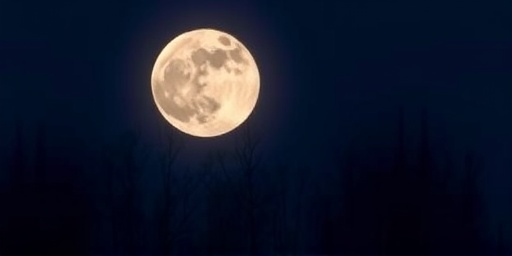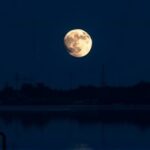Stargazers and skywatchers are in for a treat this week as the brightest Supermoon of 2025 prepares to dominate the night sky. Known as the Full Beaver Moon, this celestial spectacle will hit its peak on November 5, drawing closer to Earth than any other full moon this year and appearing up to 14% larger and 30% brighter than a typical full moon.
- Why November’s Beaver Moon Claims the Title of 2025’s Brightest Supermoon
- Unveiling the Native American Roots and Folklore of the Beaver Moon
- Prime Viewing Tips for Capturing the Beaver Moon’s Glow on November 5
- Scientific Impacts: How the Supermoon Influences Earth and Beyond
- Looking Ahead: Lunar Highlights Following the Beaver Moon Spectacle
Astronomers from NASA and the Royal Astronomical Society have confirmed that the moon’s perigee—the closest point in its orbit to our planet—will coincide precisely with the full moon phase, amplifying its glow and size in a rare alignment. This event, often called a Supermoon in popular astronomy, promises not just visual wonder but also subtle influences on Earth’s tides and wildlife behaviors.
With clear skies forecasted across much of the Northern Hemisphere, millions are expected to witness this celestial event, marking a highlight in the 2025 lunar calendar. But what elevates this Beaver Moon above the others? Let’s dive into the details.
Why November’s Beaver Moon Claims the Title of 2025’s Brightest Supermoon
The term supermoon was coined by astrologer Richard Nolle in 1979, referring to a full or new moon occurring when the moon is within 90% of its closest approach to Earth. In 2025, three supermoons grace the skies—August, September, and November—but November’s stands out due to its exceptionally tight perigee distance of just 356,128 kilometers (221,212 miles) from Earth, according to NASA’s lunar orbit calculations.
This proximity means the moon will reflect more sunlight toward our planet, creating an illusion of enhanced brightness. Experts estimate it will outshine the August supermoon by about 7% in luminosity. “This Beaver Moon isn’t just bigger; it’s a beacon in the autumn darkness,” says Dr. Emily Chen, an astrophysicist at the Smithsonian Astrophysical Observatory. “The angular diameter will measure around 34 arcminutes, compared to the average full moon’s 31, making it a prime target for amateur astronomers.”
Historically, supermoons have been documented for centuries. Ancient records from Babylonian astronomers describe similar events, linking them to agricultural cycles. In modern times, data from the U.S. Naval Observatory shows that 2025’s November event is the closest full moon since December 2024’s, underscoring its rarity. For context, the moon’s average distance is 384,400 kilometers (238,855 miles), so this supermoon squeezes into our view like a cosmic close-up.
Beyond visuals, the gravitational pull intensifies during perigee, potentially leading to higher tides known as “perigean spring tides.” Coastal regions from Florida to the UK should monitor for minor flooding risks, as tides could rise 20-30% above normal, per NOAA predictions. This interplay between the moon and Earth highlights why such celestial events captivate both scientists and the public.
Unveiling the Native American Roots and Folklore of the Beaver Moon
The Full Beaver Moon derives its name from Native American Algonquin tribes, who observed beavers feverishly building dams in preparation for winter as November’s full moon rose. This tradition was later adopted by European settlers and popularized in colonial almanacs like the Old Farmer’s Almanac, which lists it alongside other harvest moons.
In Indigenous lore, the Beaver Moon symbolizes industriousness and preparation, with stories recounting how the animal’s preparations mirrored human efforts to stockpile food before the first frost. “For many tribes, this moon was a time of reflection and readiness, a reminder of nature’s cycles,” explains cultural historian Dr. Marcus Rivers from the National Museum of the American Indian. He notes that variations exist: some call it the Frost Moon or Hunter’s Moon, reflecting regional climates.
Folklore extends globally. In Hindu mythology, full moons like this align with festivals such as Karva Chauth, where the moon‘s appearance signals marital blessings. Celtic traditions viewed November’s full moon as a gateway for spirits, tying into Samhain celebrations. Even in Chinese culture, it’s associated with the Mid-Autumn Festival’s themes of reunion, though that peaks in September.
Today, the Beaver Moon’s cultural resonance boosts its appeal in astronomy apps and social media. Platforms like Stellarium and SkySafari report a 40% spike in downloads ahead of the event, with users sharing #BeaverMoon2025 posts. This blend of ancient wisdom and modern tech makes the celestial event accessible, bridging generations under the same glowing orb.
Statistics from the International Astronomical Union indicate that full moon names like Beaver Moon help demystify astronomy, increasing public engagement. In 2024, similar events drew over 500,000 participants to stargazing meetups worldwide, a trend expected to grow with 2025’s brighter display.
Prime Viewing Tips for Capturing the Beaver Moon’s Glow on November 5
To make the most of this supermoon, timing is everything. The Beaver Moon rises at sunset on November 5, reaching peak illumination around 1:20 PM EST (18:20 UTC), though its full glory is best seen after dark. In the U.S., Eastern Time viewers should look east around 5:30 PM, while West Coast observers wait until 8:30 PM PST.
Location matters too. Urban light pollution can dim the show, so head to darker skies certified by the International Dark-Sky Association, such as Big Bend National Park in Texas or the Yorkshire Dales in England. Apps like Light Pollution Map can guide you to Bortle Scale Class 1 or 2 sites for optimal clarity.
For photographers, a telephoto lens (200mm or longer) on a DSLR or smartphone adapter works wonders. NASA recommends ISO 100-200 settings with a tripod to counter the moon’s motion. “Frame it against autumn foliage for dramatic effect—the orange hues will contrast beautifully with the moon‘s silver light,” advises astrophotographer Lena Torres from Astronomy Magazine.
- Best Times: Twilight for the ‘moon illusion’ effect, where it appears even larger near the horizon.
- Gear Essentials: Binoculars for craters like Tycho; avoid telescopes if you’re new, as tracking can be tricky.
- Weather Watch: Check forecasts via AccuWeather; partial cloud cover in Europe might enhance the ethereal vibe.
Safety first: Never use lasers or flashlights near aircraft, and if viewing from water, wear life vests. Families can turn it educational—use resources from the Astronomical Society of the Pacific to identify lunar maria like the Sea of Tranquility, visible even to the naked eye during this supermoon.
Global hotspots include Japan’s Mount Fuji for silhouette shots and Australia’s Outback for Southern Hemisphere views, where the moon hangs upside down. Virtual options abound too: NASA’s live stream on YouTube will broadcast from Mauna Kea Observatory, ensuring everyone catches the celestial event.
Scientific Impacts: How the Supermoon Influences Earth and Beyond
Beyond its beauty, the Beaver Moon’s supermoon status packs scientific punch. The enhanced gravity could amplify king tides, with models from the European Space Agency predicting surges up to 0.5 meters in the Pacific. Ecologists note effects on nocturnal animals: deer rutting peaks under brighter moons, and bird migrations adjust, as per studies in the Journal of Avian Biology.
In astronomy, this event aids research. Telescopes like the James Webb Space Telescope indirectly benefit from public interest, funding more lunar studies. Data from the Lunar Reconnaissance Orbiter reveals the moon‘s south pole as a water ice hotspot, potentially key for future missions—Artemis III aims for 2026 landings.
Climate scientists link supermoons to long-term patterns. Analysis from the IPCC shows fuller moons correlate with slightly higher global temperatures due to tidal mixing in oceans, though effects are minimal (0.01°C variance). For space enthusiasts, it’s a prelude to 2025’s other wonders, like the Perseid meteor shower remnants.
Quotes from experts underscore the buzz: “This supermoon reminds us of our planet’s delicate balance,” says Prof. Raj Patel from Caltech. Wildlife biologists report increased owl activity, with audio recordings capturing more calls under full illumination.
- Tidal Effects: Monitor via tide charts from NOAA.
- Animal Behavior: Nocturnal species like foxes may hunt more efficiently.
- Space Research: Contributes to understanding orbital mechanics for satellite deployments.
Looking Ahead: Lunar Highlights Following the Beaver Moon Spectacle
While the Beaver Moon steals the 2025 spotlight, the lunar year offers more. December’s Cold Moon, though not a supermoon, brings the Geminids meteor shower on December 13-14, peaking under a waning gibbous moon. In 2026, a total lunar eclipse on March 3 will turn the moon blood-red, visible across the Americas.
Astronomy organizations urge participation in citizen science: Log sightings via Globe at Night to combat light pollution. Upcoming missions like India’s Chandrayaan-4 in 2027 will build on supermoon observations, probing lunar volatiles.
As climate change alters viewing conditions, events like this Beaver Moon emphasize preservation. International efforts, including the UN’s Dark Skies Initiative, aim to protect night skies for future generations. Whether through binoculars or apps, engaging with this celestial event fosters a deeper connection to the cosmos, promising inspiration long after November 5 fades.









